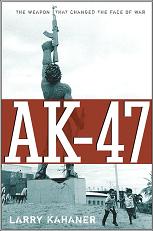
AK-47
Larry Kahaner
258 pages including index
published in 2007
The AK-47 is such an iconic weapon that it's even present on the flag of Mozambique. As a brand, ít's as global as Coca Cola, as omnipresent as McDonalds. It's the prefered weapon of every guerilla or freedom fighter everywhere and is therefore almost always used as the weapon of choice for Hollywood bad guys, just like its heroes used the true blue American M-16. More seriously, the AK-47, because it's so widespread and cheap has influenced the outcome of more wars in the past sixty years than perhaps any other weapon. In America meanwhile it not only became the symbol of the third world terorist, but also the face of domestic crime, as "the gnagbanger with an AK-47" became the symbol of the evil the gun control lobby was fighting against with the assault rifle ban.
Such an iconic weapon deserves a history that does justice to it, something that goes beyond the usual war nerd recitation of design history and
battle use, but which also looks at the cultural and political impact of the AK 47. Larry Kahaner has tried to write such a book with
the main problem is that Kahaner is unsure on what he wants to do with his book. It starts out as a conventional history of the AK-47 --how and why it got designed, its impact on western firearm design, the parallel developments of American (semi-)automatic rifles and so on, but Kahaner also wants to tell the story of Mikhail Kalashnikov himself, of how this legendary engineer who gave his name to the most important firearm of the Cold War was living in near obscurity, never having gotten anything but medals and a small state pension for his design, of how he would reduced to hawking vodka to make some money of his name. But that's not all, Kahaner also wants to talk about the cultural and political impact of the Kalashnikov worldwide, not to mention the role it supposedly plays in fueling all kinds of wars and insurgencies around the world. So you get a book that's part war nerd, part cultural history, part investigative journalism, part advocacy and it doesn't quite gell together. It reads like a collection of only partially worked out essays, an impression not helped by the short length of the book. There just isn't room for everything Kahaner wants to do with it.
Which doesn't mean the stories Kahaner tells in AK-47 aren't interesting. The way in which he writes up the origin of the Kalashnikov and parallels it with contemporary developments in the US, the impact of the weapon on the war in Vietnam is quite good; nothing new perhaps, but Kahaner does well explaining the problems and challenges designing an automatic rifle or assault rifle brings with it and how they interact. There are other stories too that are quite interesting, for example of how the FARC was supplied with a version of the AK-47 that uses a specific kind of rare caliber ammunition, through a high Peruvian government official and with suspected CIA backing; when news of this leaked out, Kahaner alleges it ultimately brought down the government of Peru's then president, Alberto Fujimore. An interesting story, but these and others don't seem to lead anywhere. What you end up with is half a book filled with interesting stories which are largely inconsequental to the main point of the book.
Because about halfway through, Ak-47 changes from being a history of the Kalashnikov into an examination of the dubious role it plays in perpetuating socalled small wars or bushfire wars. Kahaner's thesis being that the Kalashnikov, far more than the chemical or biological weapons America is so afraid of, is a true "weapon of mass destruction", having killed or maimed millions of soldiers and civilians in brushfire wars in Asia and Africa. Because it's so cheap and plentiful it has a disproportionate effect on these wars, making them that much harder to stop. Kahaner again writes well about the United Nations efforts to curtail the trade in small arms, but again the story remains hanging. He's too much of a sensible liberal to dive too deep into the politics and historical context of this arms trade and the wars it fuels, so remains focused on just one symptom, the readily availability of cheap Kalashnikovs. Again, there isn't enough room in the book to go into depth on this subject. Yet the book is largely sold on this subject, rather than as a history of the Kalshnikov itself.
All in all than this is a reasonablly entertaining history of this weapon, which attempts to be more than that but fails. Those already interested in Kalashnikov and his remarkable weapon will find little new here, those readers who pick it up based on the hype surrounding it will find it too shallow to be of much use. Unfortunately, this was a failure.